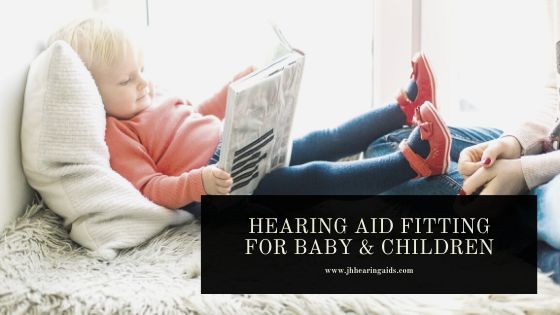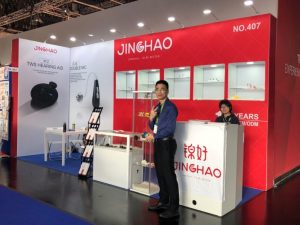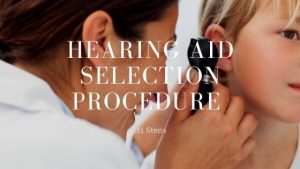
The fitting of children’s hearing aids is very different from that of adults, because the acoustic characteristics of children’s ears are different from those of adults, and children are at the stage of growth and development, which is also a critical stage of speech and language development. Significant impact. Because children often cannot cooperate to express their subjective feelings, when debugging hearing aids for children, hearing experts often worry about giving too much compensation and damage to residual hearing. On the other hand, they are afraid of insufficient compensation, which makes it difficult for hearing aids to function and make children lose language learning. Best time. This article will discuss how to fit children’s hearing aids.
1. The importance of wearing hearing aids early
The importance of early selection of hearing aids is mainly manifested in the awakening and use of residual hearing, so that deaf children can build a sound language. For example, a deaf child with a hearing threshold of 90dB can rarely feel the stimulation of daily surrounding sounds and speech communication sounds. His hearing function has always been in an unexploited state. Once wearing a suitable hearing aid, the deaf child You can feel the emergence of speech and various natural sounds, and gradually respond to various sounds. The residual hearing is developed, the auditory functions are exercised, and the hearing signals from the hearing aids are gradually distinguished and understood. Be deaf but not dumb, return to the world of sound, and return to the mainstream of society.
Therefore, in the early intervention and speech rehabilitation measures for deaf children, the selection of hearing aids is the most basic premise for hearing rehabilitation and speech rehabilitation.
The first few years after the birth of a child are the fastest periods for the development of various systems and organs, as well as the development of speech and language. Many research results show that hearing-impaired children who wear hearing aids within 6 months after birth can improve their language understanding and expression skills more than wearing 6 months later, and their speech and language development have the opportunity to reach normal hearing At the child level, this shows the importance of early diagnosis and early intervention.
2. Methods for assessing the extent of hearing loss in children
As with adults, when choosing a hearing aid for a child, you must first know the extent and nature of the hearing loss. Different hearing methods can be used to assess children’s hearing loss based on their age and cognitive maturity.
1. Newborns, infants, uncooperative toddlers and children with cognitive difficulties
Newborns, infants, uncooperative infants, and children with cognitive difficulties can not detect reliable behavioral audiometry thresholds. Objective inspection thresholds are a common choice. The goal is to select hearing aids as soon as possible to develop appropriate speech and language. These objective inspection thresholds will be used to evaluate audiometry thresholds to guide hearing aid selection.
The brainstem evoked potential test has been widely used in clinical practice. As an objective auditory function test for newborns and uncooperative young children, short latency latency brainstem response (ABR) is the most common. This test uses surface electrodes that are completely non-invasive to the subject, convenient to record, and can be performed under sleep anesthesia. Therefore, it is suitable for infants from infants to different ages. When using ABR, the air-bone conductance test response threshold with frequency characteristics is required. Because the ABR response is used as an indicator of objective hearing sensitivity, the result of short-sound stimulation cannot represent the true audiogram, and the energy of short-sound is concentrated at 2000-4000Hz, which cannot reflect other hearing states. However, the wave V response threshold is closely related to the 2000-4000Hz behavioral hearing threshold. In quiet sleep, the ABR response threshold of children with normal hearing can be as low as 20dB nHL. In addition, because most deaf children have residual hearing, especially in the low and medium frequency regions, those who fail to respond to ABR can choose an electrophysiological examination that reflects the low and medium frequency hearing valve.
When obtaining ABR data, you should also consider performing an otoacoustic emission (OAE) test. For example, some children have normal outer hair cell function, but the ABR value is very poor, their OAE test is normal, and the treatment method for these children is completely different. Generally, ABR tests show that children with hearing loss more than moderate will not have normal OAEs. If the OAE is normal and the ABR shows severe hearing loss, consideration should be given to the possibility of auditory neuropathy or test errors. The test results of acoustic impedance and stapedius reflex are also required.
After selecting hearing aids based on the estimated threshold, children must be closely followed up. At the same time, children’s growth factors should be considered. The ABR waveform of the baby will change after a period of time, which will affect the identification of the threshold. Therefore, the test must be repeated after a period of time to ensure the accuracy of the results. As they grow up, audiologists will have more hearing information and will need to update the settings in the hearing aids.
6 months to 2 years
With the increase of children’s month age, the sound localization ability gradually matures, and the hearing threshold can be measured by visual enhanced audiometry (VRA) method. VRA is suitable for children from 6 months to 2 years old, but if the child does not cooperate, ABR test or other electrophysiological tests can also be used.
3 to 5 years old
For children over 3 years old, behavioral audiometry may make a simple action response every time they hear the sound, that is, let the child take the initiative to participate in the examination, which can obtain a more accurate threshold for both ears. Therefore, children aged 3 to 5 years can use the conditional game audiometry (CPA) method to measure the hearing threshold.
School-age children
Children aged 5 to 6 can work with hearing experts for at least half an hour when conducting hearing tests and assessments. In this way, they can usually do pure tone audiometry, and can use standard audiometry instead of visual enhanced audiometry.
Finally, there are two issues to be aware of when assessing hearing loss. The first is the frequency characteristics. Because children do not have the patience to do a long-term examination, the hearing threshold of each ear’s speech frequency can be estimated, such as a low frequency (500Hz) and a high frequency (2000Hz).
Although many infants have symmetric hearing loss, there are exceptions. Secondly, because the ear canal volume of children is relatively small, for the same audiometry equipment, the sound pressure level in children’s ears is greater than in adults. Therefore, as children’s ear canals grow, their hearing thresholds will change.
There are two solutions to this, one is to mark the hearing threshold with dB SPL, and the other is to mark it with the equivalent adult hearing threshold. The equivalent adult hearing threshold refers to the hearing level of an adult with the same sound pressure level at the tympanic membrane as a child.
Obtaining reliable hearing data is the basis for selecting suitable hearing aids for deaf children. We should obtain at least low-frequency and high-frequency hearing thresholds for each ear before fitting. Moreover, the methods of discriminating hearing loss have been gradually improved and clinically Simple and easy to use, it helps to understand the nature of hearing loss and guides fitting.
3. Gain issues in the selection of hearing aids for children
1. Speech recognition and magnification requirements
Are the magnification characteristics required by children, especially infants, different from adults with the same hearing loss? There are two main aspects to this problem: First, it is related to the small ear canal and sound pressure level at the eardrum. Children need significantly different gains from adults. For the gain and maximum output at the eardrum to be as large as an adult, the required coupler gain and input sound pressure level for children is 90dB SPI_Elbow Output Sound Pressure Level (OSPL90) should be smaller than for adults. Second, whether children’s true ear gain and maximum loss Ⅲ should be different from adults, this question is difficult to answer directly.
When listening to speech, adults will use their own language knowledge and language background at that time, contact the context, and guess those whispering languages that are difficult to hear directly. Children are still in the language acquisition stage, and their speech recognition ability is worse than adults, it is difficult to guess this part of the information. For speech materials that have no semantic, syntactic, or contextual connections, such as accurate recognition of some meaningless syllables, normal hearing infants need 26dB more sound than adults. Similarly, in the monosyllable word test, for the same familiar words, the same score is required, and younger children need higher sounds than older children.
The difference in speech recognition between children and adults is more pronounced in whispering than louder. For children and adults with the same hearing loss, loud discomfort is basically the same. Therefore, the loud gain and OSPL90 values required by children are not greater than those of adults.
The previous discussion is about the total maximum output and gain. The gain of each frequency must also be considered, that is, the frequency response curve is different from the optimal frequency response curve for adults. There are different perspectives on the gain required by children. Some experts believe that children need additional high-frequency gain because high-frequency signals are the hardest for children to detect. Other experts believe that children need extra low-frequency gains first, because intonation and other signals are an important part of communication in the early stages of language development. With the development of children’s language knowledge, different frequency response curves may be required.
To achieve a certain speech recognition rate, the signal-to-noise ratio (SNR) of infants is 7dB higher than that of adults, and the signal-to-noise ratio of preschool children is 3dB higher than that of adults. This indicates that under some circumstances, adults with normal hearing can recognize rales, but children cannot.
For children and adults with the same degree of hearing loss, they need the same average gain value, but the problem of true ear gain values required by children is more difficult to grasp than adults, because children need to consider more than just a single gain. Loud gain, medium gain, and low gain. For loud and medium-intensity sounds, children do not need a higher gain than adults. If the input sound exceeds 70dB SPL, compression should be activated to reduce the gain. For whispers, as mentioned above, children’s ability to recognize whispers is poor, so they need a higher gain, which helps to recognize speech and enrich their language knowledge. Therefore, it is best for children to use wide dynamic
Hearing aid for range compression.
For adults, the prescription formula can be determined based on the loudness increase curve, while for children, it is often difficult to obtain a satisfactory loudness increase curve, and the prescription formula can only be determined based on audio explanation. Generally, for non-linear circuits, DSI_ [i / o] or NAI_-NI is recommended. 1. NAL-NL2 matching formula.
2. Small ear problems in children
The length of the ear canal determines its resonance frequency, and therefore the peak frequency of REUG REUG. As children grow, the length and volume of their ear canals increase, and the resonance frequency decreases. At birth, the peak frequency of the REuG curve is about 5000 to 6000 Hz, but by the age of 2 to 3 years, it drops to 3000 Hz on average (only 10% higher than that of adults). A person’s REUG value affects their intervention gain, and these changes need to be considered when choosing a hearing aid.
However, if it is selected based on the real-ear hearing aid gain (REAG) instead of the intervention gain, the personal REUG characteristics have no effect on the selection. However, we can estimate the ear canal length based on the peak frequency of the REUG curve, which can guide the position of the probe insertion when doing real ear analysis.
After wearing a hearing aid, the residual ear canal volume is related to age change. The residual ear canal volume and middle ear impedance characteristics jointly determine the difference between the true ear and the coupler (RECD). Infants ‘ear canal wall impedance also affects the RECD value, with’ RECD changing fastest in the first year after birth. Generally, when children are about 5 years of age, their RECD values are close to adult levels. This also suggests that ear molds should be changed for children in a timely manner.
Because the volume of the ear canal of a child is small, and the residual volume of the ear canal is small after wearing a hearing aid, the sound pressure level generated in the ear of the same child may be greater than that of an adult. Therefore, the hearing aid gain value should be corrected based on the true ear analysis data of the child.
4. Children hearing aids
Hearing aids are suitable for children with single and binaural hearing loss, mild hearing loss, and severe hearing loss. Findings from the ABR study suggest that mild hearing impairment can also cause learning difficulties for children. Children with very severe hearing loss’ Although they cannot elicit ABR waves, they cannot think that the child has no residual hearing and thus lose the opportunity to use a hearing aid that still helps him. Of course, such children may consider implantation. Cochlear implant. Children with hearing loss in both ears should wear hearing aids in both ears except in special cases.
Air-guided hearing aids are conventional hearing aids for children. Bone-guided hearing aids are suitable for atresia, narrowing, or slowness of the external auditory canal. Giant suppurative otitis media with repeated suppuration, children with large conductive hearing loss who cannot use air conduction hearing aids.
Children’s outer ears are still developing. Generally, behind-the-ear hearing aids are recommended, so that ear molds can be replaced in time to connect with other hearing aids. Compared to custom-made hearing aids, BTE hearing aids have lower repair rates.
Choose the circuit and signal processing method suitable for each child, and can flexibly adjust the frequency and output of the hearing aid according to the formula to maintain audibility, such as wide dynamic compression technology, multi-channel compression, automatic acoustic feedback control, and multiple listening programs Wait.
When matching, it is necessary to consider the acoustic characteristics of the ear related to age and individual. You can use the true ear coupling difference ‘or true ear test to verify whether the output characteristics of the hearing aid meet the requirements.
5. The role of FM wireless conversion system and the use of auxiliary hearing devices
The frequency modulation (FM) wireless conversion pump system, or FM frequency modulation system, is designed to transmit the speaker’s voice directly to the listener without reducing the signal strength and improving the signal-to-noise ratio. Therefore, the degree to which the FM frequency modulation system improves signal quality and speech intelligibility is far greater than that of hearing aid users alone. The FM system is suitable for any hearing loss patient, but it is more suitable for children, because children need a higher signal-to-noise ratio than adults, and children spend most of their time in school, mainly listening to teachers, and the speakers are more convenient to wear FM signal transmission Device. It is more convenient to use FM frequency modulation system, which is not affected by deaf children in a certain range.
Restricted and therefore suitable for outdoor teaching of deaf children. In addition to being used in schools, FM systems can also be used at home and elsewhere. For example, when watching TV, the FM signal transmitter can be placed near the TV speakers, so that deaf children can hear the sound of TV far away and reduce distortion.
When using an FM signal transmitter to speak to children, make sure that the children can receive the signal.
Children’s hearing aids can also be used to assist hearing devices such as inductive coils, pickup inputs, infrared hearing systems, and sound field amplification in classrooms to make the sound source approach or pick up the strongest and clearest signals.
Read More:
https://www.jhhearingaids.com/hearing-aids-fitting-for-children/
Link:Hearing aids fitting for baby and children
REF: Hearing Aids Supplier , ITE hearing aids, BTE Hearing AidsThe article comes from the Internet. If there is any infringement, please contact [email protected] to delete it.




